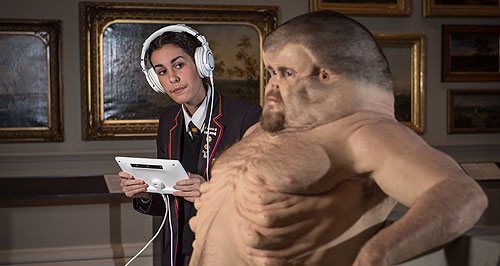Make / Model Search
News - General News - SafetyTAC car-proof human goes globalGraham TAC pedestrian vulnerability campaign attracts worldwide audienceGallery Click to see larger images 26 Jul 2016 AUSTRALIA’S Transport Accident Commission (TAC) has launched a confronting road safety awareness campaign that previews how humans may evolve if pedestrian vehicle collisions can not be prevented, but the local stunt has attracted the eyes of the world. Graham – a bizarre sculpture of a specialised person demonstrates the changes that the human body will have to undergo to survive a “low-impact” collision with a vehicle, resulting in a deformed but arguably improved human being. Since the TAC introduced Graham last week at the State Library of Victoria, his curious form has been reported by countless international publications, made one of the top trending topics on social media and clocked up more than nine million page views on the dedicated interactive website. Created by renowned Melbourne artist Patricia Piccinini with the guidance of Royal Melbourne Hospital trauma surgeon Christian Kenfield and Monash University Accident Research Centre crash investigation expert Dr David Logan, Graham highlights the vulnerability of the body when struck by a car. Just as humans have evolved over millions of years to cope with danger and threats to personal safety, Graham’s body has also changed to better survive the relatively modern hazard that traffic poses to the species. Inside his massive head, Graham’s brain is largely the same as any other but is encased in a oversized skull that does the job of a crash helmet. Voids between two bone layers act as crumple zones to reduce g-forces on the fragile brain, while more supporting ligaments prevent the brain hitting the inside of the skull. Graham’s wide, flat face is filled with more cushioning fat to prevent damage to fragile cheek bones, while his nose is recessed and less pronounced to stay out of harms way during an impact. A massive neck has sacrificed much of the movement and flexibility of today’s humans with the ribs extending up through to the base of the skull and pinning the head in one position. In a collision, the head’s inertia can cause neck and spinal injuries, but Graham’s almost shoulder-width neck controls skull momentum much like the lifesaving Hans device used by racing drivers. The ribs are another area of the body often injured in an accident and Graham has also evolved to protect the chest and abdominal regions. The thicker ribs are separated by ‘sacks’ that behave like airbags to cushion and slow deceleration, but there is no explanation why Graham needs 10 extra nipples. Abrasions caused by impact with the road are not normally life threatening but Graham has a thicker and tougher layer of skin, particularly in the areas most frequently making contact with asphalt. To minimise leg injuries, Graham’s knees can articulate in all directions not just the single plane of movement that regular knee joints function. The greater flexibility allows the leg to bend with an impact, reducing the likelihood of broken bones and joints. Like modern vehicles, Graham does not only have ‘passive’ biological safety features that mitigate injury in an imminent impact, but also has ‘active’ ability to avoid the collision in the first place. Graham’s hoof-like lower leg has an extra joint allowing him to jump further and faster, which could help him move out of the path of a vehicle if he sees it coming. TAC CEO Joe Calafiore said the awareness campaign was created to remind Victorians of the potential dangers that roads can pose. “Graham and the concept of human vulnerability goes to the heart of everything we do in road safety,” he said. “People didn’t evolve to cope with the amount of force we are exposed to when something goes wrong on the roads and that’s why we need to be safer drivers, drive safer cars and build safer roads.” With the advent of autonomous cars, the advancement of self-braking technology, crumple zones and active bonnet technology, it is unlikely humans will ever need to look like Graham, but the TAC is encouraging road users to take responsibility for their own safety rather than relying on others and technology. Graham will leave the State Library on August 8 to tour the state, taking his interactive educational experience to six other locations in Geelong, Bendigo, Ballarat, Latrobe, Mildura and Shepparton before the year is out.  Read more |
Click to shareGeneral News articlesResearch General News Motor industry news |

















Facebook Twitter Instagram